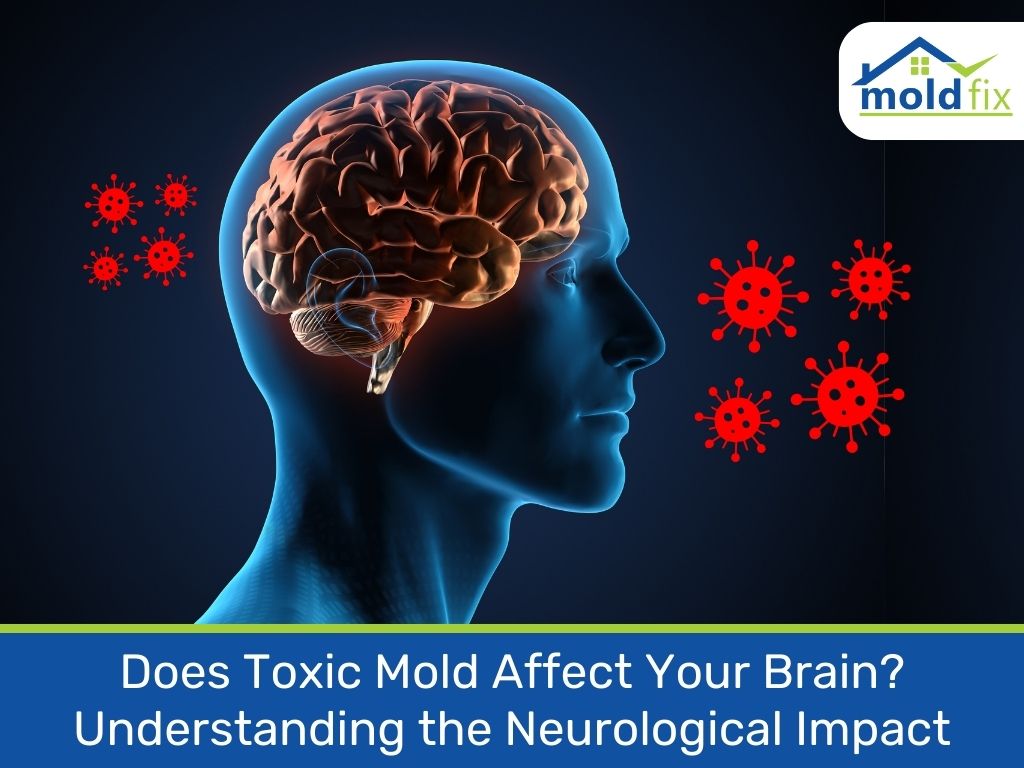Does Toxic Mold Affect Your Brain? Understanding the Neurological Impact

Imagine frequently waking up with a piercing headache or experiencing unexplained bouts of dizziness and a persistent feeling of disorientation. These are not random, unconnected incidents. They could be the neurological symptoms of mold exposure, an issue that is far more common in living spaces than most people realize. Mold, a seemingly harmless household irritant, can cause severe health effects, especially when its spores infiltrate the brain.
This article aims to shed light on this often-overlooked health risk, delving into how toxic mold affects the brain, identifying the telltale symptoms, and providing preventive strategies to protect oneself from mold-induced neurological issues.
What is Toxic Mold?
Toxic mold, a term often used to describe mold species that produce mycotoxins, refers to certain types of fungi that pose a threat to human health. The most notorious among these is Stachybotrys chartarum, commonly known as ‘black mold‘, infamous for its black-green hue and its ability to produce harmful toxins. Other types of molds such as Aspergillus, Penicillium, and Fusarium – while not always classified as ‘toxic’ – can also have detrimental effects on health, particularly in individuals with weakened immune systems or existing respiratory conditions.

Conditions conducive to mold growth are surprisingly common both in homes and workplaces. High humidity levels, poor ventilation, and areas of persistent dampness offer the perfect breeding grounds for mold. It thrives on organic materials found in buildings like wood and drywall, flourishing in basements, bathrooms, and kitchens where moisture is abundant. Understanding these conditions is the first step in preventing the onset and spread of these potentially harmful organisms.
The Brain-Mold Connection
The connection between toxic mold and brain health opens a new frontier in understanding the impact of environmental toxins on neurological functioning. These may manifest as cognitive issues like memory loss, difficulties in concentration, and severe headaches. Psychological symptoms such as anxiety, mood swings, and depression may also indicate mold brain infection. Particularly vulnerable are individuals with weakened immune systems, the elderly, and children, whose developing brains could be severely affected. Chronic exposure in such populations can result in long-lasting neurological complications. Understanding this brain-mold connection highlights the paramount importance of mold prevention and remediation in our living spaces.
Symptoms of Mold Brain Infections
The symptoms of mold-induced neurological issues can be diverse and often overlap with other health conditions, making diagnosis challenging.
Mold Exposure Symptoms

Respiratory Symptoms from Mold Exposure
Exposure to mold can cause a range of respiratory symptoms, including coughing, wheezing, shortness of breath, and chest tightness. These symptoms may be more severe in individuals with pre-existing respiratory conditions such as asthma or allergies.
Neurological Symptoms of Mold Exposure
Mold brain infections can lead to various neurological symptoms, such as headaches, dizziness, confusion, and issues with balance and coordination. In some cases, individuals may also experience numbness or tingling in their extremities.
Cognitive Symptoms of Mold Exposure
Mold brain infections can impact cognitive function, resulting in difficulty concentrating, memory problems, mental fatigue, and impaired decision-making abilities.
Fungal Brain Infections Symptoms

Cerebral Mold Infections
Severe symptoms can arise from cerebral mold infections, including seizures, changes in behavior or personality, hallucinations, difficulty speaking or understanding language, and even coma. Immediate medical attention is necessary for these symptoms.
Mold-Induced Encephalopathy Symptoms
Severe fatigue, mood swings, anxiety, depression, and insomnia characterize mold-induced encephalopathy. Muscle weakness, tremors, and involuntary body movements may also occur.
Central Nervous System Effects of Mold Exposure
Mold brain infections can affect the central nervous system, leading to symptoms such as vertigo, muscle twitches, sensory disturbances, and difficulties with coordination and motor skills.
It’s important to note that symptoms of mold brain infections can vary widely from person to person. If you suspect you may have a mold-related brain infection, it is crucial to seek medical attention for accurate diagnosis and appropriate treatment.
Health Conditions Linked to Mold Brain Infections
Mold-related brain infections can have significant implications for overall health. Not only do they trigger a range of symptoms, but they can also pave the way for the development of serious health conditions.
Impact on the immune system

Mold brain infections can compromise the immune system, rendering individuals more vulnerable to infections and diseases. The toxins released by mold can undermine the immune response, making it more challenging for the body to fend off external pathogens. This can result in frequent illnesses, prolonged recovery periods, and heightened susceptibility to other health conditions.
Long-term effects on cognitive function
Research indicates that mold brain infections can exert long-lasting effects on cognitive function. Exposure to mold toxins can impair memory, concentration, and overall cognitive abilities. Individuals may encounter difficulties with learning, problem-solving, and maintaining focus. These cognitive impairments can significantly disrupt daily life and overall quality of life.

Moreover, mold brain infections have been associated with the onset or exacerbation of neurological conditions like Alzheimer’s disease, Parkinson’s disease, and multiple sclerosis. The toxins released by mold can contribute to neuroinflammation and oxidative stress, which are known factors in the progression of these conditions.
Case Studies and Research Findings
Research and studies have shown that exposure to mold, mycotoxins, and water-damaged buildings can lead to a range of neurologic and neuropsychiatric symptoms. These symptoms can resemble those of classic neurologic disorders, such as pain syndromes, movement disorders, delirium, dementia, and balance and coordination issues. Differentiating these findings from known neurologic diseases is crucial for a better understanding of the effects of mold and mycotoxin exposure on the human nervous system. It is evident that mycotoxins can affect susceptible individuals and potentially accelerate underlying neurologic processes. However, it is essential to separate known neurologic and neuropsychiatric disorders from the effects of mycotoxins to conduct proper studies.
Furthermore, the ability of mold inhalation to cause health problems is a subject of debate. Individuals living or working in moldy environments often report various health issues such as pain, fatigue, anxiety, depression, and cognitive deficits. Another study has explored the effects of controlled mold exposure on brain function and proposed mechanisms of action. It has been observed that mold exposure can lead to innate immune activation, neural effects, and cognitive, emotional, and behavioral symptoms. Both toxic and non-toxic mold stimuli have been found to cause immune activation, impacting neurogenesis, memory, pain thresholds, and anxiety-like behavior.
In another specific case involving toxic mold exposure, a man experienced a range of neurological symptoms, including memory loss, headaches, and seizures, after residing in an apartment heavily infested with black mold. According to Joseph O’Neil, an Expert Witness, “During his time in the apartment, the man began experiencing progressively worsening neurological symptoms, including memory loss, headaches, and eventually seizures. On one occasion, the man suffered a major seizure while at home, causing him to fall down the stairs and suffer serious injuries. It was alleged that the damage to the man’s nervous system was caused by exposure to neurotoxins released by the mold infestation”. These findings emphasize the potential impact of mold exposure on neurologic health.
Overall, research and studies have shed light on the neurologic and neuropsychiatric consequences of mold and mycotoxin exposure. Understanding the distinct effects of mold exposure on the human nervous system can contribute to better management and prevention strategies for individuals affected by these conditions.
Preventing and Managing Mold Exposure
Ensuring a clean and mold-free environment in homes and workplaces is a task that requires vigilance and proactive steps. To prevent mold growth, it is crucial to implement the following strategies:

- Maintain low humidity levels in your home, ideally between 30% and 50%.
- Promptly address any leaks or water damage.
- Ensure proper ventilation in moisture-prone areas like bathrooms and kitchens.
- When renovating or building, use mold-resistant materials.
- Regularly clean and maintain your HVAC system to prevent mold buildup.
Tips for reducing mold exposure and creating a healthy environment:
- Keep your living spaces clean and clutter-free.
- Regularly clean and vacuum carpets, upholstery, and curtains.
- Utilize air purifiers with HEPA filters to eliminate airborne mold spores.
- Enhance ventilation by opening windows and utilizing exhaust fans.
- Avoid using carpets in areas susceptible to moisture, such as basements.
For individuals with compromised immune systems:

- Steer clear of areas with high concentrations of mold spores, such as damp basements or garages.
- Opt for certified mold-free products and materials in your living spaces.
- Consider wearing a HEPA-filtered mask when in potentially mold-contaminated areas.
- Keep up with regular medical check-ups to monitor any mold-related symptoms.
However, in cases of extensive mold infestation, professional remediation is recommended over DIY methods.

Mold professionals are equipped with the necessary tools and knowledge to safely remove mold and prevent its recurrence, thus ensuring a healthy living space. Therefore, it is crucial to understand when and who to call for help. If the mold-affected area exceeds 10 square feet or if there’s a persistent mold issue despite repeated cleaning, the assistance of a mold remediation expert should be sought.
Conclusion
The question of whether toxic mold is affecting your brain is a significant one. It is a call to attention, urging you to assess your living conditions for any signs of this invisible enemy. Remember, the key to managing this risk lies in early detection, proactive steps, and professional intervention when needed.
Should you suspect the presence of mold in your home or office environment, don’t hesitate. Reach out to the experts at Mold Fix, who can provide professional assessment and mold remediation services. Call us today at (949) 449-5949, and let us help you ensure a healthy, mold-free living space.


